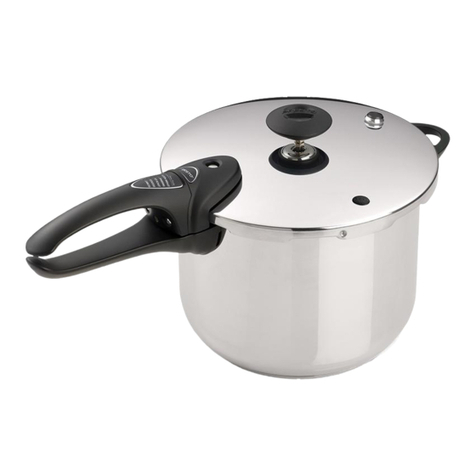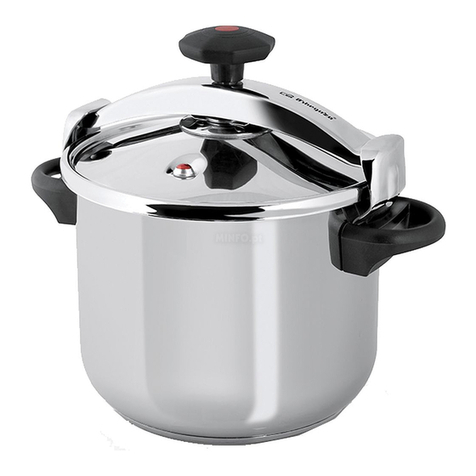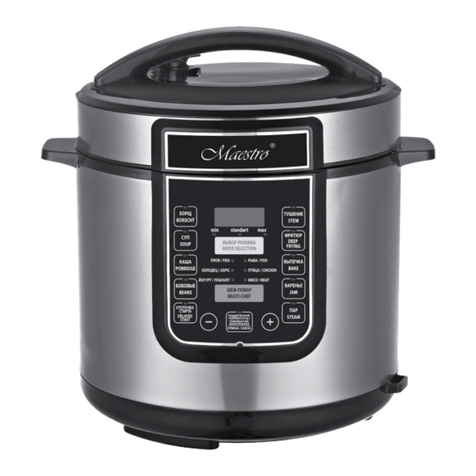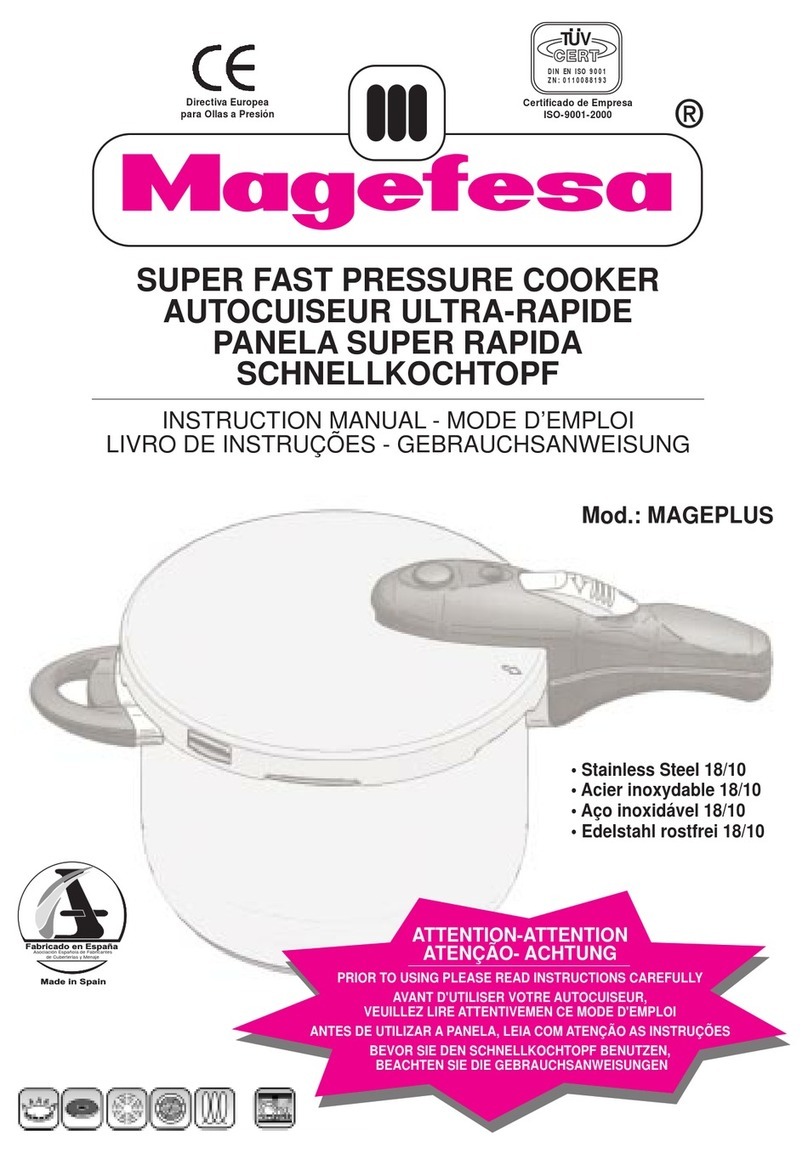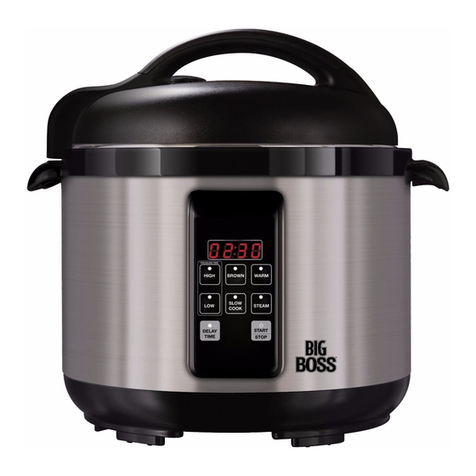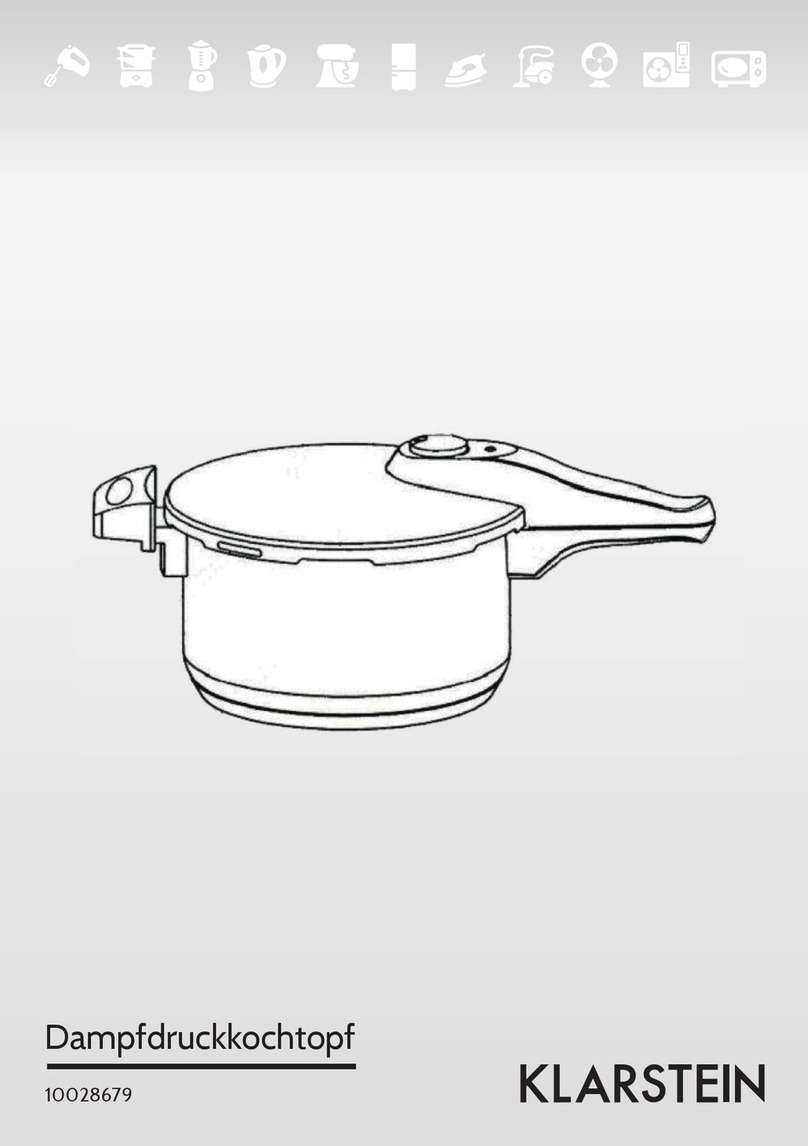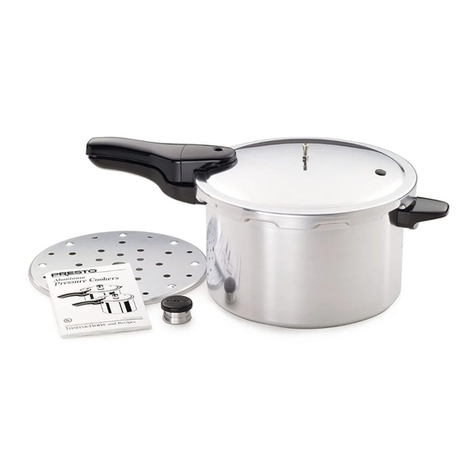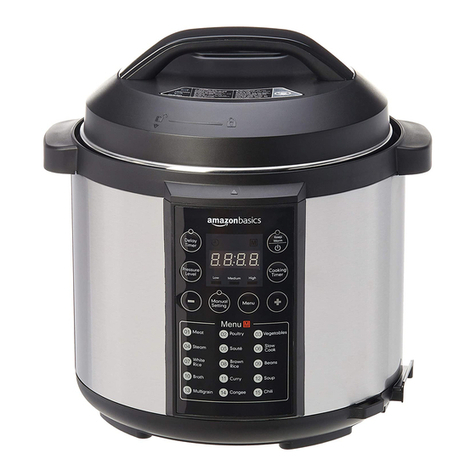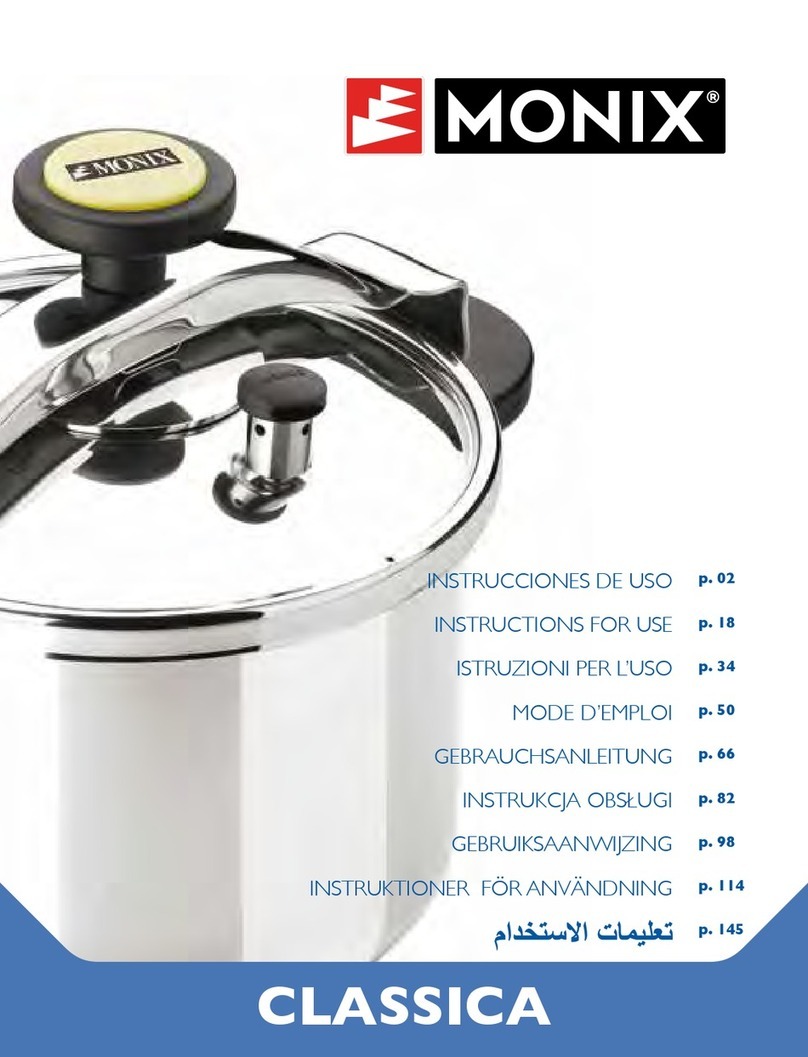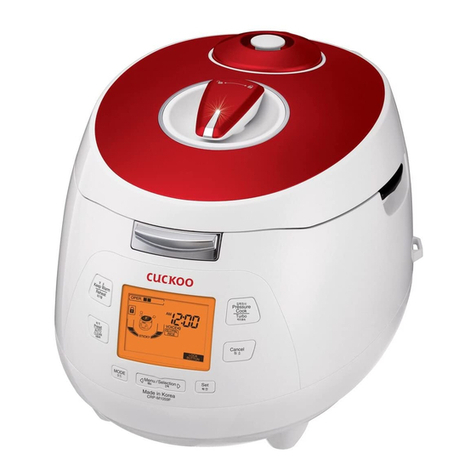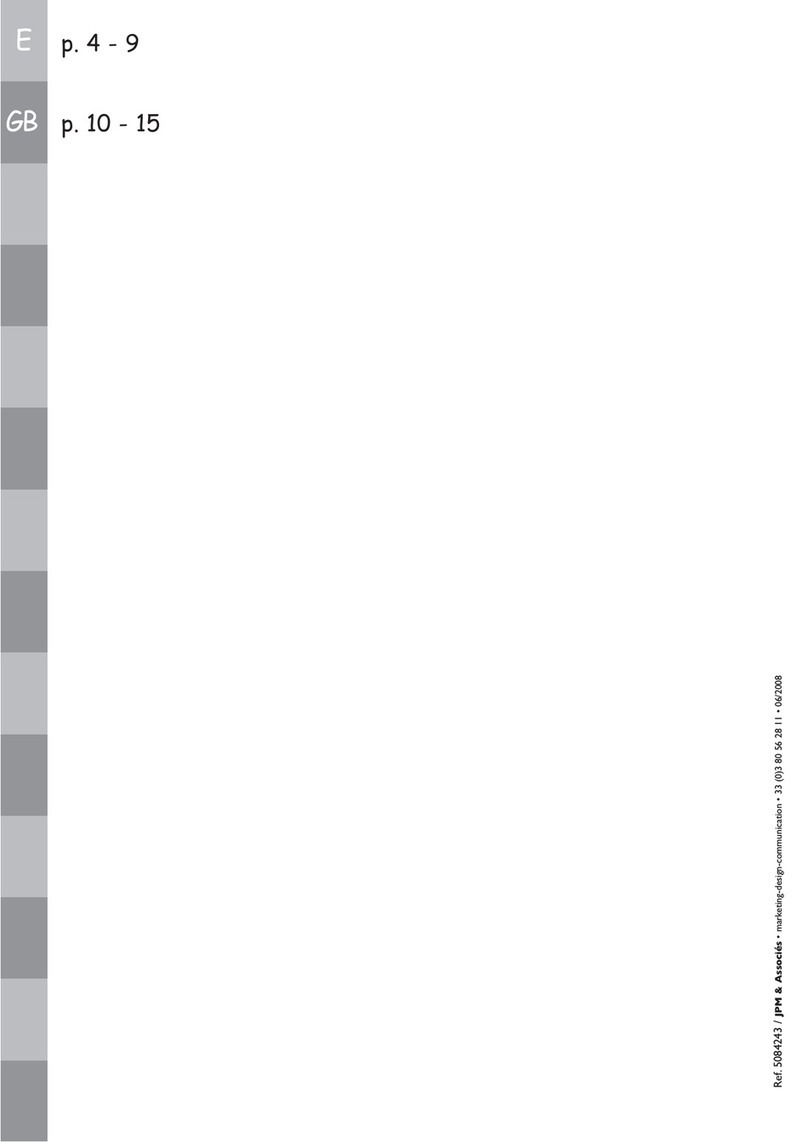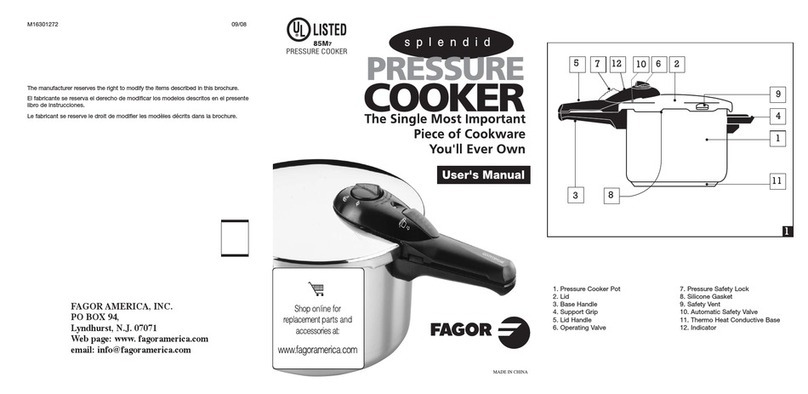Electrolux Professional Thermaline Pro Thermetic PUET User manual

Operating and installation
instructions
(Translation of the original operating instructions)
DOC no. 87.8031.01 - EN
Edition 4 (01-2020)
Pro Thermetic
TILTING PRESSURE BRAISING PAN
PUET MODEL
Gas powered │PUET-G
A BC

Operating and installation instructions │Pro Thermetic │Tilting pressure braising pan PUET-G
EN │01-2020 87.8031.01 2
CONTENT OVERVIEW
CONTENT OVERVIEW ........................................................................................... 2
FOREWORD............................................................................................................ 4
1. GENERAL INFORMATION ..................................................................................... 5
1.1 INTRODUCTION .......................................................................................... 5
1.2 IDENTIFYING YOUR COOKING APPLIANCE............................................. 5
1.2.1 Cooking appliance identification plate........................................................... 5
1.2.2 Meaning of the identification plate fields ....................................................... 5
1.3 LIABILITY ..................................................................................................... 6
1.3.1 Storing the operating instructions ................................................................. 6
1.3.2 Recipients of operating instructions .............................................................. 6
1.4 GENERAL INFORMATION .......................................................................... 6
1.4.1 Explanation of markings and symbols........................................................... 6
1.4.2 Installation and commissioning ..................................................................... 6
1.4.3 Operator's obligations ................................................................................... 7
1.4.4 Intended use................................................................................................. 7
1.4.5 Safety ........................................................................................................... 7
1.4.6 Handling industrial cooking appliances ......................................................... 8
1.4.7 Customer services, service, repair and maintenance work........................... 9
1.4.8 Maintenance intervals................................................................................... 9
1.5 ENVIRONMENTAL PROTECTION .............................................................. 9
1.5.1 Packaging..................................................................................................... 9
1.5.2 Disposal...................................................................................................... 10
1.6 CLEANING ................................................................................................. 10
1.6.1 Suitable cleaning products.......................................................................... 10
1.6.2 Cleaning instructions................................................................................... 10
1.6.3 Cleaning the appliance ............................................................................... 10
1.7 TRANSPORT, HANDLING AND STORAGE .............................................. 11
1.7.1 Introduction................................................................................................. 11
1.7.2 Unloading.................................................................................................... 11
1.7.3 Handling instructions................................................................................... 11
1.7.4 Moving the appliance and setting down the load ........................................ 11
1.7.5 Storage ....................................................................................................... 11
2. APPLIANCE FUNCTIONS AND EQUIPMENT...................................................... 12
2.1 OVERVIEW ................................................................................................ 12
2.2 APPLIANCE FUNCTION ............................................................................ 12
2.3 DESIGN AND SET UP ............................................................................... 12
2.3.1 Brief description of the most important working parts ................................. 13
2.4 EXTENSION OPTIONS.............................................................................. 13
2.5 TESTS/ CERTIFICATES ............................................................................ 13
3. TECHNICAL SPECIFICATIONS ........................................................................... 14
3.1 VALIDITY AND IDENTIFICATION.............................................................. 14
3.2 APPLIANCE MODEL CODING................................................................... 14
3.3 TECHNICAL DOCUMENTATION............................................................... 14
3.4 TYPE OF INSTALLATION.......................................................................... 14
3.5 STANDARD APPLIANCES......................................................................... 14
3.6 TECHNICAL DETAILS ............................................................................... 15
3.6.1 Sub-systems.............................................................................................. 15
4. INSTALLATION AND ASSEMBLY ....................................................................... 16
4.1 DIMENSION DRAWINGS FOR FLOOR AND WALL INSTALLATION ....... 16
4.1.1 Floor and wall mounted appliances............................................................. 16
4.1.2 Wall mounted appliances............................................................................ 17
4.2 INSTALLATION DIAGRAMS AND CONNECTIONS .................................. 18
4.2.1 Floor and wall mounted appliances............................................................. 18
4.2.2 Wall mounted appliances............................................................................ 19
4.3 FLOOR OUTLET AND GUTTERS ............................................................. 20
4.4 APPLIANCE INSTALLATION ..................................................................... 20
4.5 ACCESS TO THE INSIDE OF THE APPLIANCE....................................... 21
4.5.1 Removing panel fronts................................................................................ 21
4.5.2 Removing panel cover ................................................................................ 21
4.5.3 Removing service cover.............................................................................. 21
4.5.4 Removing side panels................................................................................. 21
4.5.5 Removing protective covers........................................................................ 21
4.5.6 Refitting all covers ...................................................................................... 21
4.6 ASSEMBLY AND SET UP.......................................................................... 22
4.6.1 Floor installation: free-standing or standing against a wall.......................... 22
4.6.2 Wall installation: wall-mounted.................................................................... 23

Operating and installation instructions │Pro Thermetic │Tilting pressure braising pan PUET-G
EN │01-2020 87.8031.01 3
CONTENT OVERVIEW
4.7 ASSEMBLING APPLIANCE GROUPS....................................................... 24
4.8 GAS CONNECTION ................................................................................... 25
4.8.1 General information and important instructions .......................................... 25
4.8.2 Appliances mounted on the floor and against a wall ................................... 26
4.8.3 Wall mounted appliances............................................................................ 26
4.8.4 Sealing the gas pipes.................................................................................. 27
4.8.5 Flue gas evacuation.................................................................................... 27
4.8.6
Installing appliance under extraction hood .............................................. 27
4.8.7 Testing the connection pressure................................................................. 27
4.8.8 Adjusting the gas flow speed on ignition ..................................................... 28
4.8.9 Burner spacing............................................................................................ 28
4.8.10 Thermal load............................................................................................... 28
4.9 ELECTRICAL CONNECTION..................................................................... 29
4.9.1 Connectors ................................................................................................. 29
4.9.2 Connecting to a potential equalisation system............................................ 30
4.9.3 Potential-free contact (PC).......................................................................... 30
4.10 MIXER TAP ................................................................................................ 31
4.10.1 Drinking water connection........................................................................... 31
4.10.2 Appliance: free-standing or standing against a wall .................................... 31
4.10.3 Appliance: Wall-mounted............................................................................ 31
5. COMMISSIONING ................................................................................................. 32
5.1 PREPARATION.......................................................................................... 32
5.2 ADDING THE FOOD .................................................................................. 32
5.3 DECOMMISSIONING................................................................................. 32
6. CHECK LIST: COMMISSIONING ......................................................................... 33
7. CHECK LIST: MAINTENANCE ............................................................................. 34
8. OPERATING THE TOUCH CONTROL ................................................................. 36
8.1 DESCRIPTION OF THE CONTROL PANEL.............................................. 36
8.2 OPERATING THE MAIN FUNCTIONS....................................................... 36
8.2.1 Main selection menu................................................................................... 36
8.2.2 Default settings........................................................................................... 36
8.2.3 Manual........................................................................................................ 37
8.2.4 Phase ......................................................................................................... 37
8.2.5 Temperature selection (in °Celsius)............................................................ 37
8.2.6 Temperature selection (via power levels) ................................................... 37
8.2.7 Selecting cooking time (entering time and continuous cooking)
.................. 38
8.2.8 Selecting cooking time via core temperature sensor (in °Celsius) .............. 38
8.2.9 Delayed start............................................................................................... 38
8.2.10 Pressure cooking ........................................................................................ 39
8.2.11 Preventing pressure reduction .................................................................... 39
8.2.12 Soft cooking................................................................................................ 40
8.2.13 Saving programmes.................................................................................... 40
8.2.14 Programmes ............................................................................................... 40
8.3 OPERATION AND METHODS OF YOUR COOKING APPLIANCE........... 41
8.3.1 Cooking with target value temperature and cooking time ........................... 41
8.3.2 Cooking with target value power levels and cooking time........................... 41
8.3.3 Cooking with target value temperature and core temperature sensor......... 42
8.4 ERROR AND ALARM MESSAGES............................................................ 42
9. OPERATING SUB-SYSTEMS............................................................................... 43
9.1 APPLIANCE TILTING DEVICE .................................................................. 43
9.2 PRESSURE LID ......................................................................................... 43
9.2.1 Pressure lid components ........................................................................... 43
9.2.2 Pressure lid operating instructions sticker................................................... 43
9.2.3 Operating pressure lid ................................................................................ 44
9.3 LID SAFETY VALVE................................................................................... 45
9.3.1 How to operate the safety valve.................................................................. 45
9.3.2 Dismantling and cleaning the safety valve .................................................. 45
9.4 DRAIN TAP ................................................................................................ 46
9.4.1 Removing food............................................................................................ 46
9.4.2 Removing the drain tap............................................................................... 46
9.4.3 Servicing the drain tap ................................................................................ 46
10. ACCESSORIES ..................................................................................................... 47
APPENDIX
(Gas settings tables, SVGW guidelines) ............................................... +

Operating and installation instructions │Pro Thermetic │Tilting pressure braising pan PUET-G
EN │01-2020 87.8031.01 4
FOREWORD
The operating and installation instructions provide the user with useful information for operating the machine or cooking
appliance safely and make it easy for him to operate the tilting pressure cooker.
The following description will not be a boring, tedious list of instructions and warnings but a range of aids that are
suitable for optimising the appliance performance in every respect and will help prevent incorrect use and handling
that could cause injury to people and animals and material damage.
It is very important that all people entrusted with the transport, installation, commissioning, use, maintenance, repair and
disposal of the appliances read the operating instructions carefully prior to dealing with the appliance in order to prevent
incorrect operating steps or errors as a result of which the appliance could be damaged or which could constitute a risk
of accident for those people.
The operating instructions must always be available to the operating staff and therefore be stored at the workplace
in an easily accessible place where they can be consulted at any time in case of doubt or when required.
Should you have any doubts or uncertainties concerning the use of the machine or cooking appliance after reading
the operating and installation instructions, please contact Electrolux Professional or your closest customer service
centre who will gladly assist you to optimise the performance of the appliance.
It must be remembered that when using the appliance the relevant regulations with respect to safety, work hygiene
and environmental protection must be complied with. It is therefore the duty of the user to ensure that the appliance
is always used in safety conditions that are optimum for persons, animals and material items.
The manufacturer does not accept any liability for damage that arises from improper storage or misuse of your cooking
appliance. No product liability is accepted for unauthorised adaptations and modifications that do not comply with
the instructions in this handbook. In some circumstances this will invalidate the guarantee.
Manufacturer:
Electrolux Professional AG
Allmendstrasse 28
CH - 6210 Sursee / Switzerland
Documentation:
Electrolux Professional AG
Tech. Docu Services
CH - 6210 Sursee / Switzerland
Original version: German.
Other language versions are available from Electrolux Professional Customer Services.
Misprints, errors and alterations excepted.

Operating and installation instructions │Pro Thermetic │Tilting pressure braising pan PUET-G
EN │01-2020 87.8031.01 5
1GENERAL INFORMATION
1.1 INTRODUCTION
Thank you for choosing a quality product from the Electrolux Thermaline Pro Thermetic - product range.
Read the instructions in this document carefully. They contain important information on installation and operational safe-
ty as well as on the use and maintenance of the appliance. Store the documents so that they are always available for
users. These instructions relate to various appliance models.
1.2 IDENTIFYING YOUR COOKING APPLIANCE
You will find the precise model name of your cooking appliance on the
identification plate under "F.Mod". Further details and specifications of
your model can be found in →Chapter 2 "Appliance function and equip-
ment" and →Chapter 3 "Technical specifications".
1.2.1 Cooking appliance identification plate
The 8-digit series number on the ID plate is compiled as follows:
Until 11/2013:
Y WW XXXXX
Y is the last figure of the year of manufacture
WW stands for the week of manufacture
XXXXX is the consecutive serial number
From 11/2013:
3 38 1 0003
Y WW Z XXXX
Y Fourth digit of the year in numbers (2013)
WW Calendar week (38)
Z Third digit of the year in numbers (2013)
XXXXX 3. Appliance with this PNC, produced in calendar week 38
1.2.2 Meaning of the identification plate fields
F.Mod. .................. (A) Appliance model
Comm. model....... (B) Trade name
Ser. no. ................. (C) Serial number
Swiss made.......... (D) Place of manufacture
99-9999 (E) Month-year
of manufacture
PNC (F) Product number code
EL: ........................ (G) Voltage [V]
(H) Number of live/
neutral wires
Hz ......................... (I) Power frequency [Hz]
kW ........................ (J) Power consumption [kW]
A ........................... (K) Current consumption [A]
EL: ........................ (L) Additional information
Gas type…………... (M) Type/ amount of gas
∑........................... (N) Cpl. appliance gas power
Xxx........................ (O) Test centre/ certification
Type........................ (P) Model
IPX ........................ (Q) Water protection class
CE ......................... (R) CE mark
Xxx........................ (S) Country specification
Cat. ....................... (T) Gas category
P mbar (U) Gas pressure
ELX ....................... (V) Manufacturer:
Electrolux Professional AG
Allmendstrasse 28
CH-6210 Sursee (Switzerland)

Operating and installation instructions │Pro Thermetic │Tilting pressure braising pan PUET-G
EN │01-2020 87.8031.01 6
1.3 LIABILITY
The manufacturer is indemnified from all product liability in the following cases:
Disregarding the information in these operating instructions.
Repairs that were performed improperly and the use of spare parts that are not listed in the spare parts catalogue
(the installation and use of non-original spare parts or non-original accessories can cause permanent damage
to the operation of the appliance).
Interventions by unqualified technicians.
Unapproved modifications or interventions.
Negligent maintenance.
Improper use of appliance.
Spraying the appliance with a strong water or steam jet or using a high pressure cleaner is not permitted.
The use of harsh cleaning agents or acids must be expressly avoided.
Exceptional unforeseeable circumstances.
Non-compliance with the regulations for workplace safety, hygiene and health that are in effect in the appliance us-
er’s country.
Furthermore, any liability for damage that is caused by conversions and independent modifications made by the us-
er or the customer will be refused.
The responsibility for the selection of the appropriate individual means of protection for the operating staff shall
remain with the employer or with the safety officer at the workplace in accordance with the provisions in effect
in the appliance user’s country.
Read all these installation instructions carefully before you install and operate the appliance. Any additions and
amendments to the operating instructions that the manufacturer may send to the customer shall form an essential
part of the operating instructions and must be stored together with them.
Electrolux Professional shall bear no responsibility for any inaccuracies in the operating instructions and installation
instructions that are due to printing or translation errors.
1.3.1 Storing the operating instructions
The operating instructions must be kept intact for the whole life cycle of the appliance up until it is disposed of.
The operating instructions must always accompany the appliance if it is transferred, sold, rented, allowed to be used
by others or leased.
1.3.2 Operating instruction recipients
The operating instructions are intended for:
staff who are responsible for transport and handling.
installers who set up and commission the appliance.
the employer of the appliance users and the safety officer at the workplace.
the staff who operate the appliance.
specialist engineers from Customer Services (→see electrical wiring diagram and service manual).
the people responsible for disposal.
1.4 GENERAL INFORMATION
1.4.1 Labelling and explanation of symbols
IMPORTANT!
Risk to the health and safety of employees.
INSTRUCTION
Important instruction that must always be obeyed.
1.4.2 Installation and commissioning
The installation and initial operation of the appliance must be properly carried out in accordance with
the manufacturer's instructions and may only be done by an authorised specialist from Electrolux Pro-
fessional.
The electricity, water and gas supplies must be installed by certified specialists complying with
country-specific and local regulations.
They bear full responsibility (→see also 4.8 Gas connection).
The appliance may not be operated without the user first familiarising himself/herself with its use.
The operating instructions and the safety precautions must be followed carefully. Follow the cautions
and warnings on the appliances themselves.
The appliance must only be installed in a sufficiently ventilated area.

Operating and installation instructions │Pro Thermetic │Tilting pressure braising pan PUET-G
EN │01-2020 87.8031.01 7
1.4.3 Operator's obligations
The responsibility for and guarantee of the constant correct operation of all safety-related components
(pressure lids, pressure lid locks, pressure lid safety valves, pressure switches, excess temperature
safety thermostat, gas burners, ignition devices, adjustment equipment, main gas tap, gas valves,
gas burner control units, the gas impermeability of all pipes etc.) fall to the responsible manager.
The correct operation of safety-related components must be tested at least once each calendar year
by Electrolux Professional authorised specialist engineers and replaced if necessary.
The user of the appliance is responsible for making sure the national guidelines on safe use are fully
complied with.
The local fire protection regulations must be fully complied with.
Swiss SVGW regulations: (→see Appendix).
1.4.4 Intended use
The boiling pan is intended for use only for the preparation and processing of food in commercial
kitchens such as restaurants, hospitals, staff canteens, butcher shops and food production companies.
Any other form of use is in contravention of its purpose and can therefore represent a risk to people, an-
imals or objects.
The appliance must only be inspected and operated by technically trained people.
The appliance must only be operated if all safety equipment and safety devices are available, installed
properly and fully functional.
The appliance's performance data must not be changed.
The appliance must not be operated in the vicinity of inflammable materials or vapours.
The maximum level must not exceed the maximum level mark. The quantity selected must be lower
with pressure cooking and depending on the type of food to be cooked in order to prevent foaming over.
Improper use (e.g. exceeding the maximum fill mark) may cause scalding as a result of hot food spilling
and/or flowing over the edge of the pot.
Heating solid food that does not conduct heat well can cause it to burn onto the bottom.
Caution: Risk of fire!
Do not place any objects on the lid or on the heating zones during use.
Do not heat up covered containers due to the risk of explosion and injury.
The use of hazardous substances, such as highly concentrated vinegar essence, citric acid, limescale
cleaners or flammable substances, on our cookers is strictly forbidden.
Overheated oil can self-ignite. Never put water on burning oil but put out the flames with a lid or a damp
cloth.
The pressure cooker must not be used to dry tea towels and other textiles.
The pressure cooker must not be used in the open air and in uncovered outside areas.
1.4.5 Safety
The appliance is only to be used for cooking food in commercial operations.
The operator must ensure that the place where the gas appliance is installed is sufficiently ventilated.
Fluctuations in gas quality and gas pressure must be within the prescribed tolerances.
In the event of deviations that exceed the permissible values the appliance must not be operated.
In the event of a gas leak there is the risk of fire and explosion. What to do if there is a gas leak and you
can smell gas: - do not smoke, do not fan flames, - do not operate any electrical switches or use your
mobile phone, - turn off the valves on the gas bottles and the main gas tap on the appliance, - ventilate
the room thoroughly (create a draught).
Closed containers (Cans, tins, canisters, bottles, tubes etc.) must not be heated up with the appliance
because they will explode and may thus cause injuries.
When closing the lid there is the risk of injury if the person operating the appliance is not sufficiently
far away from the lid closing area (you could crush your fingers and hand or hit your head).
When you open the lid be aware of hot steam coming out of the pot. The appliance operator must take
this into account and take appropriate measures (stand at a distance, protect arms) in order to prevent
injuries.
Important! Danger of trapping hands between tilting pots and fixed appliance parts.
There is an increased risk of scalding when emptying the frying pan.
The waste gas outlet is hot. You must not touch it.
The waste gas outlet must not be covered with anything.
Important: Performing repairs on safety valves is not permitted. If it is faulty or leaks the whole safety
valve must be replaced by an authorised specialist.

Operating and installation instructions │Pro Thermetic │Tilting pressure braising pan PUET-G
EN │01-2020 87.8031.01 8
If the temperature control is not functioning 100%, switch the appliance off immediately.
Remove the appliance’s main fuse. Do not use the appliance if damaged in any way.
When putting oil, fat, water or ingredients in the preheated hot frying pan, they may spit.
This action must therefore be carried out by the appliance operator with due care.
Overheated fats and oils ignite quickly in the hot frying pan. Always take care when cooking with fats
and oils.
The appliance must not be used for deep frying.
The use of corrosive, poisonous and inflammable substances in our cooking appliances is strictly
forbidden.
After pressure cooking, cooking with a closed lid or pressure cooking in the oven itself, activate the
pressure release function before taking any other action.
After cooking with the lid closed, either without pressure or with excess pressure, refrain from opening
the lid until the appliance has expelled all the pressure. Take particular care if the food is bubbling.
If the lid is opened with a slight residual excess pressure, hot food may pour out and injure the operating
staff.
Pay particular attention to simmer-delay. Simmer delay is the name of the phenomenon that under
certain conditions (e.g. on high mountains or plateaux where the air pressure is lower that at sea level)
liquids can boil at lower than 100°C and therefore can be heated beyond their boiling point without them
simmering, boiling or bubbling. This situation is dangerous because the slightest movement can quickly
cause a large steam or gas bubble to form that can then explode out of the cooking pot.
Our appliances are partially thermally insulated and insulated. The temperatures required for the cook-
ing processes in industrial cooking appliances, depending on the function principle, mean that various
parts (e.g. cover areas, cladding panels etc.) can get hot. This is not a design fault but caused by the
physical phenomenon that stainless steel conducts heat.
Do not spray the appliance with water, steam or high pressure cleaners and do not pour water over it.
This appliance is not intended to be used by children and people with restricted physical, sensory and
mental faculties or who have a lack of experience and/or knowledge unless they are supervised by a
person responsible for their safety or have received instructions from this person on how the appliance
is to be used.
1.4.6 Handling industrial cooking appliances
The built-in stainless steel components for industrial cooking are made of high-quality and approved materials.
The sum of their positive characteristics makes them ideal materials for use in food preparation.
The reason the anti-rust stainless steel can resist corrosion is a passive layer which builds up when oxygen hits the
metal surface. There is sufficient oxygen in the air to do this.
If this passive layer is damaged by mechanical effects or damaged chemically and the passive layer is prevented from
regenerating itself (lack of oxygen) even rust-free stainless steel may corrode. It is possible to develop or regenerate the
passivity by treating it with running oxygen-rich water. Degenerative (oxygen starving) abrasives, such as substances
containing hydrochloric acid, chlorides and spice concentrates, mustard, vinegar essences, spice cubes and cooking
salt solutions can cause chemical damage or destruction of the passive layer depending on the concentration and the
temperature. In addition damage may occur due to external rust (small iron parts) by the formation of galvanised ele-
ments and by lack of oxygen (no ventilation or low-oxygen water).
Note, therefore, the following principles when working with stainless steel appliances:
Keep stainless steel surfaces clean at all times and make sure they are well ventilated. Do not place the
lid on appliances when not in use so that air can get to the surface. Regularly wipe away any build-up of
lime scale, grease, flour and egg white. A layer of any of these substances can encourage corrosion by
starving the surface of air. Descaling can be carried out with a solution of 10% vinegar, 10% phosphoric
acid or a suitable commercially available descaling agent.
Do not let stainless steel parts come into prolonged contact with acids, spices, salts, etc.
Even acid fumes which build up from cleaning tiled surfaces can promote corrosion. Rinse off work sur-
faces with fresh water. This applies especially after cooking potatoes, pasta or rice in salted water.
Dried-up cooking water creates a highly concentrated salt solution which can quickly cause corrosion.
For this reason, rinse cookware immediately after use with fresh water or fill with cold water and leave to
cool down. It is uneconomical to use an appliance solely for the purpose of, for example, boiling pota-
toes in salted water. Instead, with stainless steel it is sensible to fill the appliance with various types of
food, e.g. with soups with a high fat content or acidic vegetables (such as pickled cabbage).
Avoid physical damage to the stainless steel surface, especially with other metals. If stainless steel
comes into contact with iron (wire wool, swarf from cables, iron-rich water) this can lead to corrosion.
Remove fresh rust with a mild scouring agent or fine abrasive paper. Wash away stubborn rust with a
warm 2-5% oxalic acid solution. If these cleaning agents do not work, treat the rust with 10% nitric acid.
Because of the risk involved, this treatment may only be applied by technically trained staff in accord-
ance with the applicable guidelines.
Information on cleaning the appliance (→see 1.6.3 Cleaning the appliance)

Operating and installation instructions │Pro Thermetic │Tilting pressure braising pan PUET-G
EN │01-2020 87.8031.01 9
1.4.7 Customer services, service, repair and maintenance work
Service, repair and maintenance work must only be carried out by Electrolux Professional or
Electrolux partner dealers. Country-specific and local regulations apply. This applies in particular to
safety and regulatory installations. A service contract is therefore recommended
Before starting any service, repair or maintenance work, the appliances must be disconnected from
the mains supply (Turn the main switch off or remove the fuses from the power supply), the gas supply
turned off, the steam, condensate and drinking water pipes closed off.
Maintenance work on the gas supply must only be carried out by the gas supply company or an author-
ised installer.
Parts to be replaced must be replaced by original Electrolux parts.
The warning and information notices fitted to the appliances must be obeyed by specialist and customer
service staff and must not be removed or altered.
The responsibility for and guarantee of the constant correct operation of all safety-related components
(pressure lids, pressure lid locks, pressure lid safety valves, pressure switches, excess temperature
safety thermostat, gas burners, ignition devices, adjustment equipment, main gas tap, gas valves, gas
burner control units, the gas impermeability of all pipes etc.) fall to the responsible manager.
These components must be tested at least once every calendar year by Electrolux Professional
authorised specialist engineers to ensure that they are working properly and replaced if necessary.
When operating the cooking appliance for maintenance work you must remember that there are moving
parts, such as fans, inside the appliance. (There is a high risk of injury). Take extreme care.
The appliance must be blocked via external valves prior to performing maintenance work on pressure
parts.
Repairs and service on the appliances must be carried out when heating elements have cooled down.
Do not use any inflammable liquids to clean the appliance.
In the event of a persistent defect that prevents operation, switch off the appliance and disconnect it
from the mains.
The internal electrical wiring in the appliance and the connections to the earth cable are in accordance
with the respective wiring diagrams and must not be modified. All metal parts which have electrical
connections on them must remain earthed.
Similarly constructed cooking appliances are not under obligation to be certified. They are subjected
to pressure and function tests at the factory in accordance with the relevant guidelines.
A repeated pressure test is not absolutely necessary.
In the interest of the appliances’ full functional capacity and safety, the operator should periodically
arrange for an inspection of all safety devices and a function test for the safety valve.
The inspection interval for checking that the safety valve can move freely must be individually deter-
mined and ensured by the operator depending on the intensity of use and the operating hours for the
pressure cooker. However it must take place at least once each calendar year.
1.4.8 Maintenance intervals
Depending on the frequency and intensity of use, functional parts must be maintained and tested
consistently at regular intervals. However this must be at least once a calendar year.
Electrolux Professional recommends the conclusion of a maintenance agreement.
1.5 ENVIRONMENTAL PROTECTION
1.5.1 Packaging
All packaging materials used are environmentally-friendly. They may be stored without risk, taken to
a recycling centre or incinerated in special waste incineration plants.

Operating and installation instructions │Pro Thermetic │Tilting pressure braising pan PUET-G
EN │01-2020 87.8031.01 10
1.5.2 Disposal
The WEEE symbol on the appliance means that this appliance must not be disposed of with the normal
household waste but must be disposed of in accordance with the conditions in force so that no danger to
the environment or the health of people can occur.
Should you require further information on disposing of this appliance, please contact a sales or customer
service representative, the retailer of this product, or your local waste disposal service.
1.6 CLEANING
1.6.1 Suitable cleaning products
For environmental protection reasons it is recommended that the appliance is cleaned only with prod-
ucts which are more than 90% biologically degradable.
The appliances must be cleaned with commercially available, food compatible cleaning agents.
No bleaching, chlorine-based, highly flammable, granular or abrasive cleaning agents must be used
to clean the appliance.
1.6.2 Cleaning instructions
Before cleaning the appliance must first of all be disconnected from the power supply and cooled
down completely to avoid the risk of scalding or electric shock.
The cooking appliance must be cleaned after each cooking procedure. If the cooking appliance has
a drainage tap to discharge the contents, this must be cleaned and greased by kitchen staff every day
depending on the frequency of use after the last use of the cooking appliance.
1.6.3 Cleaning the appliance
General: Only non-toxic cleaning agents should be used for cleaning. After cleaning the cooking appli-
ances must be thoroughly rinsed with water and rubbed dry. The surfaces of our cooking appliances
are made of rust-resistance chromium nickel steel.
They must be washed with a hot mild cleaning agent and rubbed dry.
They must not be cleaned with wire brushes, wire wool, copper cloths, sand-based products or similar
because using such agents damages the surfaces and creates conditions for corrosion attacks.
Spraying the appliances or parts thereof with a high-pressure cleaning hose is harmful and can lead to
functional damage.
This must therefore be prohibited.
Boiling pans and frying pans: Wash pans with a mild cleaning agent and a brush.Then rinse with hot
water and rub dry with a cloth or absorbent paper. To prevent the risk of corrosion salted water or food
must not dry onto the pot. Do not spray the appliance with a high-pressure cleaner. Clean the floor
directly in front of, next to and behind the appliance in the usual way, i.e. not using a high-pressure
cleaner.
Outer casing: Wash the outer casing of the appliance with a mild cleaning agent, rub dry and polish
with metal polish if necessary. Do not use wire brushes, copper cloths, wire wool or similar products.
Drain tap: Dismantle the drain tap unit, clean with a mild cleaning agent, dry and grease lightly with a
special odourless, tasteless, food-safe tap and fittings grease. We recommend: Special grease for taps
and fittings (for tap with seal/ O ring) = Order number: 0G5343,
Lubricant for taps with metal seals (for taps without seal/O-ring) = Order number: 0G5344.
Optional accessories (such as GN containers etc.): These loose parts must be cleaned separately from
the cooking appliance.
Cleaning of tilting appliances have to be done in the horizontal position (not tilted) to avoid the entrance
of water into the gas chamber

Operating and installation instructions │Pro Thermetic │Tilting pressure braising pan PUET-G
EN │01-2020 87.8031.01 11
1.7 TRANSPORT, HANDLING AND STORAGE
1.7.1 Introduction
Appliances must be transported (i.e. moved from one place to another) and handled (i.e. moved within the company
premises) using lifting devices with a suitable load-bearing capacity. The appliance can be transported by truck, train,
ship or aircraft. Apart from road transport the appliance is sent in a container together with other appliances.
The appliances can be loaded inside the container either by the manufacturer or the assigned carrier.
Due to the appliance dimensions it is not permitted to stack the appliances on top of each other during transport.
In such cases the manufacturer will not be liable should the load tip over. The manufacturer shall under no circumstanc-
es be liable for damage to the packaging or the appliances. The transport, handling and storage of the appliances must
be carried out only by specialist workers who:
- have specific technical training and experience;
- know the safety regulations and the legal provisions of their specialist area;
- have knowledge about general safety provisions;
- are able to recognise and avoid possible dangers.
The staff who are responsible for the transport, handling and storage of the appliances must be trained in the use
of hoisting aids and have sufficient knowledge to use the individual means of protection for the work to be carried out
(e.g. work wear, safety shoes, safety gloves and hard hats).
1.7.2 Unloading
Prior to removing the transport fastenings you must ensure that the stability of the appliance components does not
depend on the fastenings and that the load cannot fall from the vehicle as a result. Standing under hanging loads
during loading and unloading is prohibited. Unauthorised persons are prohibited from accessing the work area.
Prepare a suitable location with an even floor for the unloading and storage of the appliances.
1.7.3 Handling instructions
To ensure that that appliances are lifted safely, the following precautions must be observed:
• Use equipment with suitable characteristics and sufficient load bearing capacity (e.g.: forklift or
electric pallet truck);
• cover sharp edges;
• check the forks and observe the precautions on the packaging during lifting.
Prior to lifting:
• Ensure that all workers remain at a safe distance and prevent unauthorised people from entering
the work area;
• Check the stability of the load;
• Ensure that no material can fall during vertical movements and avoid bumps;
• Lift the appliances as little as possible when shifting them.
1.7.4 Moving the appliance and setting down the load
The driver of the hoisting aid must:
• have a good overview of the distance to be travelled;
• be able to stop driving in dangerous situations.
Prior to setting down the load you must ensure that the thoroughfare is free and the floor is even and that a device
with sufficient load bearing capacity is available.
1.7.5 Storage
The appliances and/or their parts must be protected from moisture and stored in a dry, vibration-free room with a non-
aggressive atmosphere and a temperature of 5°C / 41°F to 50°C / 122°F. The storage area must have a horizontal,
level contact surface in order to prevent the appliances becoming misshapen or the support feet being damaged.
The appliances may only be installed, assembled and disassembled by specialist workers. The accessories delivered
with the appliances must not be changed. Any parts that have been lost or are faulty must be replaced with original
parts.

Operating and installation instructions │Pro Thermetic │Tilting pressure braising pan PUET-G
EN │01-2020 87.8031.01 12
2. APPLIANCE FUNCTIONS AND EQUIPMENT
2.1 OVERVIEW
A Pressure lid
B Safety valve
C Panel
D TOUCH control unit
controls
E USB connection
F Pan
G Tilt function handle
H Flue for combustion gases
2.2 APPLIANCE FUNCTION
The tilting pressure braising pan is a multi-functional cooking appliance which is used to sear, fry, stew, grill, make sauc-
es, saute, poach, steam, pressure cook, boil, simmer, braise and cook and pressure cook foods of all kinds.
The food is heated via the thick-walled base of the pan under which the gas burner system is located.
The durable multiple burner system with electric ignition ensures optimum temperature distribution, a high level of
temperature stability and precise temperature control. The pan is compatible with GN containers (for available insert
frames →see 10 Accessories).The pressure lid is fitted with a safety mechanism which prevents it being opened
when pressurised. The safety valve is used to vent the air and to limit the steam pressure in the oven/ pan.
Advanced cooking methods using the core temperature sensor (e.g. when used inside a roast located in the oven),
and the TOUCH control unit as a temperature sensor are amazingly simple to use. The tilting pressure braising pan
is equipped with an electronic control system. It is operated via a user-friendly, self-explanatory touch screen display
user interface. The main functions include:
Programmable cooking processes.
Loading and storing all parameters for individual and multi-phase cooking processes on a USB disc.
Large, clear simultaneous display of actual and target values.
Real time clock.
Programmable timer for individual and user-specific cooking start.
A generous selection of nine power levels will help your individual cooking requirements, methods and techniques.
Soft cooking for gentle heating of sensitive foodstuffs and cooking ingredients.
Precise adjustment of the water supply (with automatic water filling accessory).
Capturing, recording and evaluating cooking data (locally and transferred via USB port).
For further information and a detailed description of all common cooking functions
(→see Chapter 8 OPERATING THE TOUCH CONTROL).
2.3 DESIGN AND STRUCTURE
The outer and inner structure of the whole cooking appliance is made of stainless steel (AISI 304). The pan that comes
into contact with the food is made of high quality, rust-free stainless steel (AISI 316L). The surface of the pressure cook-
er is finely polished ensuring the highest level of hygiene, universal versatility, ease of cleaning while preventing
any mixing of flavours in the food. The lid is balanced. The pan can be tilted 90° thus ensuring that the food can be re-
moved easily. The pressure cooker is tipped at variable speeds using an electric motor. Optional (only if ordered with
the appliance. Cannot be retrofitted). It is also possible to fit the pressure cooker with a food discharge tap which is
used to provide the specific dose of the food to be discharged or to pump it out using filling systems or to fill containers.

Operating and installation instructions │Pro Thermetic │Tilting pressure braising pan PUET-G
EN │01-2020 87.8031.01 13
2.3.1 Brief description of the most important working parts
The electronic TOUCH control is used to operate the cooking appliance.
Safety thermostats are used to guard against overheating.
Food and floor sensors are used for precise temperature control of the required cooking process.
Pressure reduction system, is responsible for reducing the pressure in the oven and consists of pipework
with an inbuilt motor and a cold water solenoid.
Pressure reduction temperature sensor stops the pressure reducing after an active pressure cooking process.
Lid safety valve prevents impermissible excess pressure (>0.45 bar) in the oven and requires regular maintenance
(→see 9.3 Lid safety valve).
A gas burner system heats the thick-walled base of the pan.
Electric tilting is used to empty the pressure cooker.
A micro switch is used to switch the gas burner off when the pan is tilted.
Lid is used to reduce energy losses and to reduce heating times in the closed position.
2.4 EXTENSION OPTIONS
Optional extras can be added to all the tilting pressure cookers listed below.
Caution: Individual accessory items (*) cannot be retrofitted and must be ordered with the appliance because they
are integrated into standard appliances at the factory. Please contact the factory first of all to ensure that they are
available and that extension is possible.
Below there is a round up of optional extras:
Mixer tap*
Automatic water filling device (Cold water/ hot and cold water)*
Spray gun*
Main switch (power supply)*
Energy optimisation EO / Potential free contact PC
Measuring stick
Suspension frame for GN containers
Perforated GN insert
Base sheet, perforated
Gnocchi drainer
Drain tap for discharging food*
Overall panel cover to connect the panels of two cooking appliances*
Back panel (C board)* and other accessories can be added on request.
2.5 TESTS/ CERTIFICATES
All appliances are DVGW/VDE/TÜV tested. They meet the following standards and directives:
2009/142/EG, EN 203-1, EN 203-2/8, EN 203-3
2014-35/EU (LVD); EN 60335-1, EN 60335-2-39, EN 60335-2-102
2014/30/EU (EMC); EN 62233, EN 55014-1, EN 55017-2
EN 61000-4-2, EN 61000-4-3, EN 61000-4-4, EN 61000-4-5, EN 61000-4-6
2006/42/EC (MD)
2011/65/EU (RoHs2); EN 50581
2014/68/EU (PED), AD2000
ISO 9001:2008, ISO 14001:2004
The appliances are marked with the CE symbol on the identification plate. All appliances are tested and approved
for water protection class IP X6. Obtaining the full functionality of the water protection class requires the full functional
efficiency of all seals and the correct assembly of all components following installation, repair and service work.
The appliance’s noise level is low to the point of negligible. Legal regulations are met. The sound pressure level is
lower than 70dB (A).

Operating and installation instructions │Pro Thermetic │Tilting pressure braising pan PUET-G
EN │01-2020 87.8031.01 14
3. SPECIFICATIONS
3.1 VALIDITY AND IDENTIFICATION
This document deals with the following appliance model types in the Pro Thermetic product range with the following
names (can be found on the identification plate, →for this see Section 1 "General information"):
Gas powered PUET09G PUET17G
with core temperature sensor PUET09L PUET17L
3.2 APPLIANCE MODEL CODING
P = Pro Thermetic product range, U = Universal pan / braising pan, E = rectangular, T = Tilting / Kippbar,
06-50 = Capacity in litres (x10), G = Gas powered without core temperature sensor, L = Gas powered with core
temperature sensor.
3.3 TECHNICAL DOCUMENTATION
Operating and installation instructions 87.8031.01 supplied with appliance
Spare parts catalogue 87.8031.02 in the customer services centre
Service manual 87.8031.03 in customer services centre
Parameter programming 87.8005.01 in the customer services centre
Electrical wiring diagram Supplied with the appliance and published in the service manual
3.4 TYPE OF INSTALLATION
The tilting pressure cooker is optionally available as:
freestanding as an island, on feet, chromium steel or concrete base
freestanding against the wall, on feet, chromium steel or concrete base
wall-mounted.
3.5 STANDARD APPLIANCES
Appliance Width Depth Height
Base
feet
Gas (El.)
power
Net
weight
Pan
size Voltage
Fre-
quency
Current
rating
PNC Type mm kW kg lt. V Hz A
586250 PUET09GCCx
1200
900
700 200
18 (0.2) 240 90
230V/1N 50/60 1
586251 PUET09GGCx 800 100
586252 PUET09GVCx 400 --
586253 PUET09LCCx 700 200
586254 PUET09LGCx 800 100
586255 PUET09LVCx 400 --
586256 PUET17GCCx
1600
700 200
29 (0.2) 340 170
586257 PUET17GGCx 800 100
586258 PUET17GVCx 400 --
586259 PUET17LVCx 400 --
586260 PUET17LCCx 700 200
586261 PUET17LGCx 800 100

Operating and installation instructions │Pro Thermetic │Tilting pressure braising pan PUET-G
EN │01-2020 87.8031.01 15
3.6 TECHNICAL DETAILS
3.6.1 Sub-systems
PUET09 PUET17
General appliance information:
Max. oven operating pressure 0.45 bar
Water protection IP X6
Gas power 18kW 29kW
Internal pan dimensions:
Width/ depth/ height 680/558/274 1050/558/326
Dimensions heating surface:
Width / depth 610 x 480 980 x 480
Working temperature 25-250 °C
Useable capacity (up to max. fill level mark) 90 170
Gas quantities: (1013 mbar / 15°C / at sea level)
Natural gas H (m3/h) 1.86 3.00
Natural gas L (m3/h) 2.17 3.48
Propane (kg/h) 1.40 2.25
Butane (kg/h) 1.42 2.29
3.6.2 Performance data: Water heating times*?? (as per DIN18855-1: 2005 (-07)
PUET06 PUET09 PUET11 PUET17
Water heating times
Net capacity in litres (=max.
fill quantity) 67? 94? 104? 145?
Heating from: 20-90 C°
Time required: in minutes
empty pan 10
Filled totally with water 28 43 32 48
Energy consumption in kW
Efficiency as a %
Half filled with water 16 23 19 27
Energy consumption in kW
Efficiency as a %
Heating time (see table): Heating the empty pan when cold (20°C) until it attains
an average base temperature of 230°C.

Operating and installation instructions │Pro Thermetic │Tilting pressure braising pan PUET-G
EN │01-2020 87.8031.01 16
4. INSTALLATION & ASSEMBLY
4.1 DIMENSION DRAWINGS FOR FLOOR AND WALL INSTALLATION
4.1.1 Appliances installed on the floor and against a wall

Operating and installation instructions │Pro Thermetic │Tilting pressure braising pan PUET-G
EN │01-2020 87.8031.01 17
4.1.2 Wall mounted appliances

Operating and installation instructions │Pro Thermetic │Tilting pressure braising pan PUET-G
EN │01-2020 87.8031.01 18
4.2 INSTALLATION DIAGRAMS AND CONNECTIONS
4.2.1 Appliances installed on the floor and against a wall
EI Electrical connection
G Gas connection
(Customer's supply pipe: Natural gas/ town gas = 1" DN25 / Liquid gas = 3/4" DN20)
HWI Hot water inlet (G 1/2", NW15)
CWI Cold water inlet (G 1/2", NW15)
D Condensate outlet
BF Floor attachment points
Info Steel or wall plinth – standard 100mm (for appliance height: 800mm)
Steel or wall plinth – hygienic 200mm (for appliance height: 700mm)

Operating and installation instructions │Pro Thermetic │Tilting pressure braising pan PUET-G
EN │01-2020 87.8031.01 19
4.2.2 Wall mounted appliances
EI Electrical connection
G Gas connection
(Customer's supply pipe: Natural gas/ town gas = 1" DN25 / Liquid gas = 3/4" DN20)
HWI Hot water inlet (G 1/2", NW15)
CWI Cold water inlet (G 1/2", NW15)
D Condensate outlet
BW Wall attachment points

Operating and installation instructions │Pro Thermetic │Tilting pressure braising pan PUET-G
EN │01-2020 87.8031.01 20
4.3 FLOOR OUTLET AND GUTTERS
Tilting models are fitted with a loose grate and floor outlet in the base tray near the water outlet. These help drain away
the water when the appliance is cleaned. The base trays can be designed for a single appliance or for a whole group of
appliances. They vary greatly in shape and size. Please refer to the relevant installation diagram for positioning and use.
The trays are usually cemented into the floor with an outlet.
Installation:
Island freestanding /
Insel freistehend
Installation:
Wallstanding /
An Wand stehend
4.4 INSTALLING THE APPLIANCE
The appliance should always be installed in its intended location according to the relevant diagrams.
The appliance should be connected to fixed cables. Individual or groups of appliances can be fitted:
- freestanding as an island - standing against a wall, on feet, chromium steel or wall plinth (P) and
- wall-mounted on a wall or an installation wall.
Noise and vibration emissions: When installing the appliances, no additional measures are specified for
the purpose of decreasing noise and vibration as the limit values are under-run by a significant amount.
This manual suits for next models
5
Table of contents
